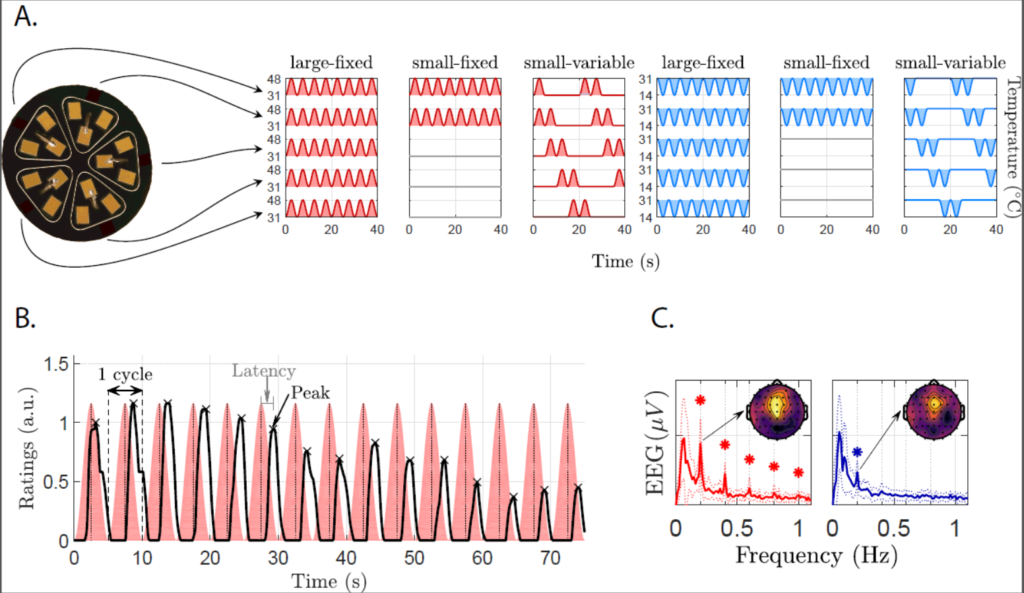
Dounia Mulders received the M.Sc. degree in Mathematical Engineering in 2016 and the Ph.D. degree in Engineering Science and Technology in 2020, both from UCLouvain. During her Ph.D., she worked on the design of experimental paradigms and signal filtering algorithms to probe thermal perception and associated brain responses in humans. She is now a Postdoctoral Research Fellow in the Fiete Lab at MIT, in the Department of Brain and Cognitive Sciences and the McGovern Institute. Her core research interests currently lie in exploring the computational principles governing sensory perception, using statistical models and artificial neural networks.
Computational methods for EEG recordings during periodic sensory stimulation
Understanding how the human brain processes sensory stimuli remains challenging. For this purpose, brain responses elicited by brief stimuli and recorded with scalp electroencephalography (EEG) have been widely considered. Besides, much less is known about the dynamics of EEG responses and subsequent perception evoked by longer-lasting, tonic stimulation. Whereas phasic responses can be extracted from background noise through averaging across trials, it is far more difficult to highlight tonic responses without any temporal cues along long time intervals.
In this context, this work considers periodic sensory stimulation to better link brain responses to input tonic stimuli. This offers several advantages, as a periodic stimulus elicits periodic activity in the neuronal populations responding to the stimulus, referred to as a steady-state response (SSR). In the frequency domain, the stimulus-evoked activity concentrates at the frequency of stimulation and its harmonics, and can thus hopefully be isolated from non-stimulus-related activity. In the time domain, the known periodicity also conveniently enables highlighting the dynamics of the elicited responses. This approach is adopted and implemented to study thermosensation, a vital sense to allow proper thermoregulation, to identify textures and to assess threats arising from noxious thermal stimuli. The EEG responses and perception elicited by warm and cool stimuli whose intensities are slowly and periodically modulated are recorded and analyzed. The baseband EEG responses as well as ongoing oscillations in physiological frequency bands are described in the time, frequency and time-frequency domains.
Besides, despite the advantages of periodic stimulation, their benefits remain conditioned to a sufficient signal-to-noise ratio (SNR) of the analyzed responses. Unfortunately, EEG recordings typically exhibit a very low SNR, harming their direct exploitation in numerous applications. For this reason, one needs to develop, compare and assess dedicated signal processing techniques to faithfully identify the stimulus-related activity. We therefore propose and compare methods to extract periodic components from multidimensional recordings. These approaches consist in spatial filters maximizing the periodicity of the extracted components. Simulations illustrate how the SNR of SSRs can be significantly enhanced to help enabling the use of periodic stimulation in practical contexts.
Fig. 1. Illustration of periodic thermal stimulation. When a periodic stimulus is applied to a subject (A), both its perceived intensity (B) and the brain responses (C) from the neuronal populations responding to the stimulus are expected to oscillate at the same frequency. This knowledge can therefore guide the identification of the stimulus-evoked responses in the time and frequency domains. Warm and cool stimulation time courses are shaded in red and blue respectively.
Associated publications:
https://journals.plos.org/plosone/article?id=10.1371/journal.pone.023169
https://dial.uclouvain.be/pr/boreal/object/boreal%3A200698/datastream/PDF_01/view

